Human Resource Management, Leadership, and HRM Models: Unilever
VerifiedAdded on 2023/01/13
|16
|4646
|69
Report
AI Summary
This report examines the human capital management practices of Unilever PLC, a multinational consumer goods company. It analyzes Unilever's approach to HRM, focusing on relevant HRM models such as the Harvard Model, the HR Value Chain, and the Standard Causal Model, evaluating their application within the company. The report delves into key HR functions including recruitment and selection, HR development (training), and employee motivation, discussing their significance and providing recommendations for improvement. The analysis considers various HR issues Unilever faces, such as staff turnover, performance management, and competition. The report provides insights into how Unilever can optimize its HRM strategies to enhance employee productivity, improve operational efficiency, and achieve its business objectives. It also mentions features of effective leaders to benefit the company.
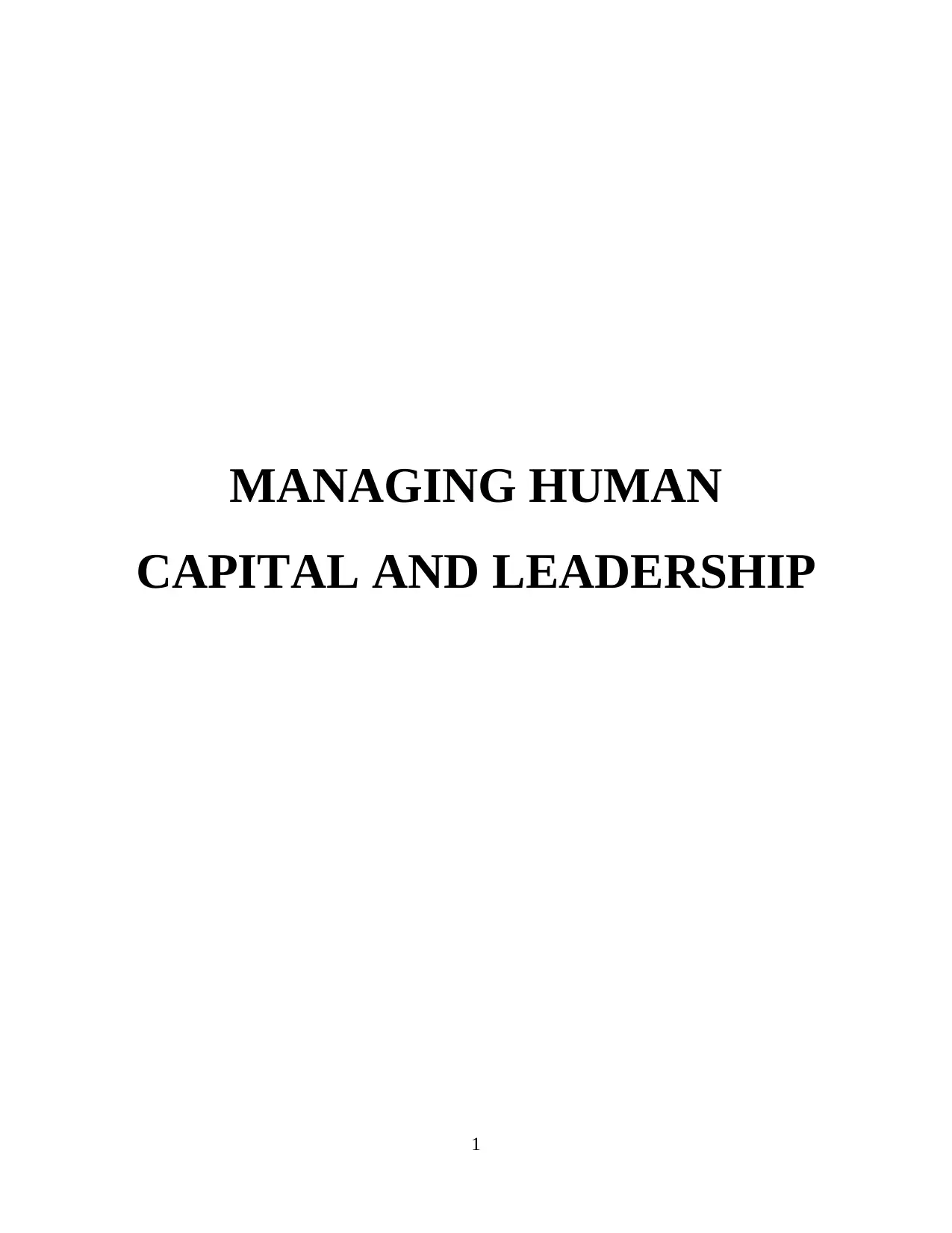
MANAGING HUMAN
CAPITAL AND LEADERSHIP
1
CAPITAL AND LEADERSHIP
1
Paraphrase This Document
Need a fresh take? Get an instant paraphrase of this document with our AI Paraphraser

2
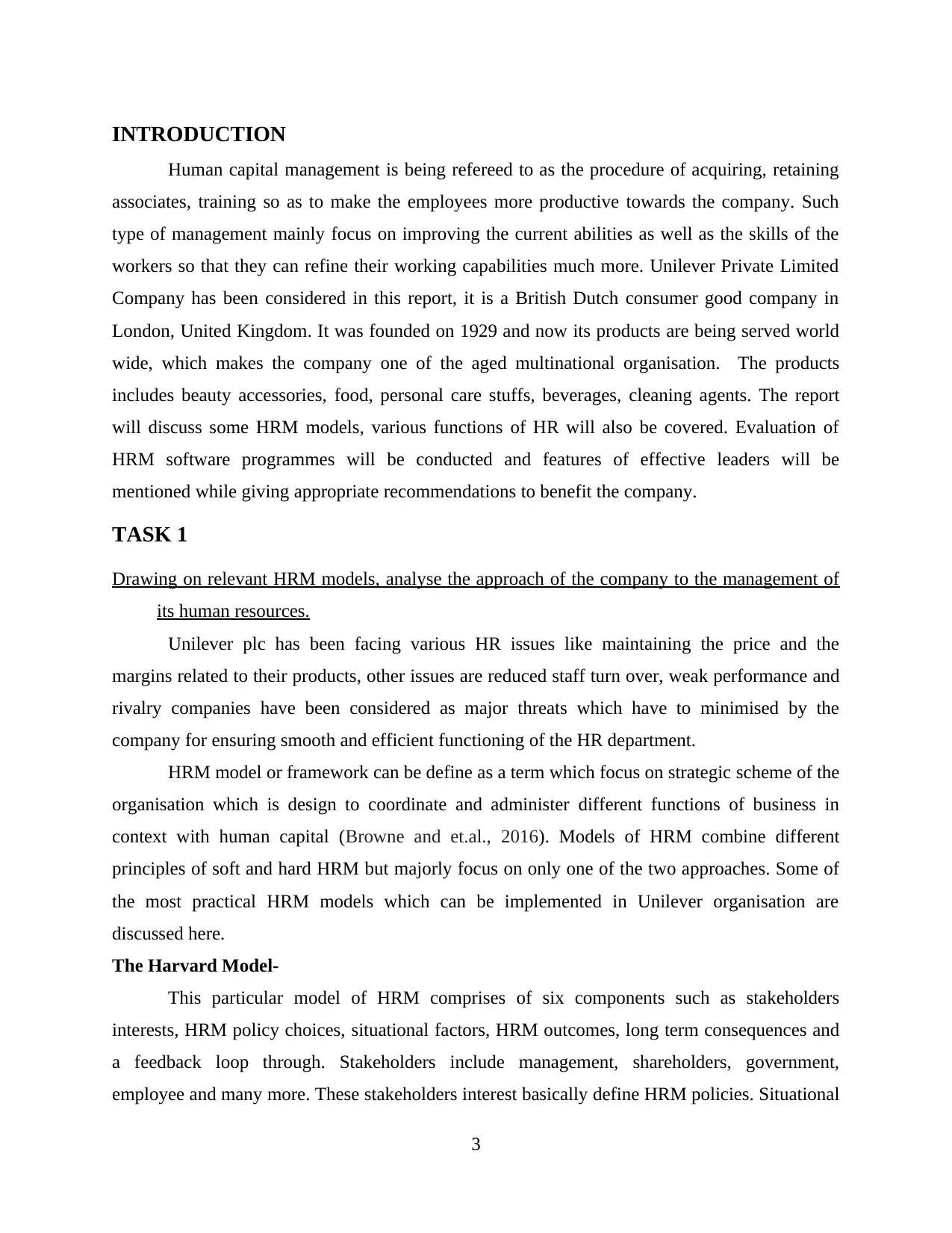
INTRODUCTION
Human capital management is being refereed to as the procedure of acquiring, retaining
associates, training so as to make the employees more productive towards the company. Such
type of management mainly focus on improving the current abilities as well as the skills of the
workers so that they can refine their working capabilities much more. Unilever Private Limited
Company has been considered in this report, it is a British Dutch consumer good company in
London, United Kingdom. It was founded on 1929 and now its products are being served world
wide, which makes the company one of the aged multinational organisation. The products
includes beauty accessories, food, personal care stuffs, beverages, cleaning agents. The report
will discuss some HRM models, various functions of HR will also be covered. Evaluation of
HRM software programmes will be conducted and features of effective leaders will be
mentioned while giving appropriate recommendations to benefit the company.
TASK 1
Drawing on relevant HRM models, analyse the approach of the company to the management of
its human resources.
Unilever plc has been facing various HR issues like maintaining the price and the
margins related to their products, other issues are reduced staff turn over, weak performance and
rivalry companies have been considered as major threats which have to minimised by the
company for ensuring smooth and efficient functioning of the HR department.
HRM model or framework can be define as a term which focus on strategic scheme of the
organisation which is design to coordinate and administer different functions of business in
context with human capital (Browne and et.al., 2016). Models of HRM combine different
principles of soft and hard HRM but majorly focus on only one of the two approaches. Some of
the most practical HRM models which can be implemented in Unilever organisation are
discussed here.
The Harvard Model-
This particular model of HRM comprises of six components such as stakeholders
interests, HRM policy choices, situational factors, HRM outcomes, long term consequences and
a feedback loop through. Stakeholders include management, shareholders, government,
employee and many more. These stakeholders interest basically define HRM policies. Situational
3
Human capital management is being refereed to as the procedure of acquiring, retaining
associates, training so as to make the employees more productive towards the company. Such
type of management mainly focus on improving the current abilities as well as the skills of the
workers so that they can refine their working capabilities much more. Unilever Private Limited
Company has been considered in this report, it is a British Dutch consumer good company in
London, United Kingdom. It was founded on 1929 and now its products are being served world
wide, which makes the company one of the aged multinational organisation. The products
includes beauty accessories, food, personal care stuffs, beverages, cleaning agents. The report
will discuss some HRM models, various functions of HR will also be covered. Evaluation of
HRM software programmes will be conducted and features of effective leaders will be
mentioned while giving appropriate recommendations to benefit the company.
TASK 1
Drawing on relevant HRM models, analyse the approach of the company to the management of
its human resources.
Unilever plc has been facing various HR issues like maintaining the price and the
margins related to their products, other issues are reduced staff turn over, weak performance and
rivalry companies have been considered as major threats which have to minimised by the
company for ensuring smooth and efficient functioning of the HR department.
HRM model or framework can be define as a term which focus on strategic scheme of the
organisation which is design to coordinate and administer different functions of business in
context with human capital (Browne and et.al., 2016). Models of HRM combine different
principles of soft and hard HRM but majorly focus on only one of the two approaches. Some of
the most practical HRM models which can be implemented in Unilever organisation are
discussed here.
The Harvard Model-
This particular model of HRM comprises of six components such as stakeholders
interests, HRM policy choices, situational factors, HRM outcomes, long term consequences and
a feedback loop through. Stakeholders include management, shareholders, government,
employee and many more. These stakeholders interest basically define HRM policies. Situational
3
⊘ This is a preview!⊘
Do you want full access?
Subscribe today to unlock all pages.

Trusted by 1+ million students worldwide
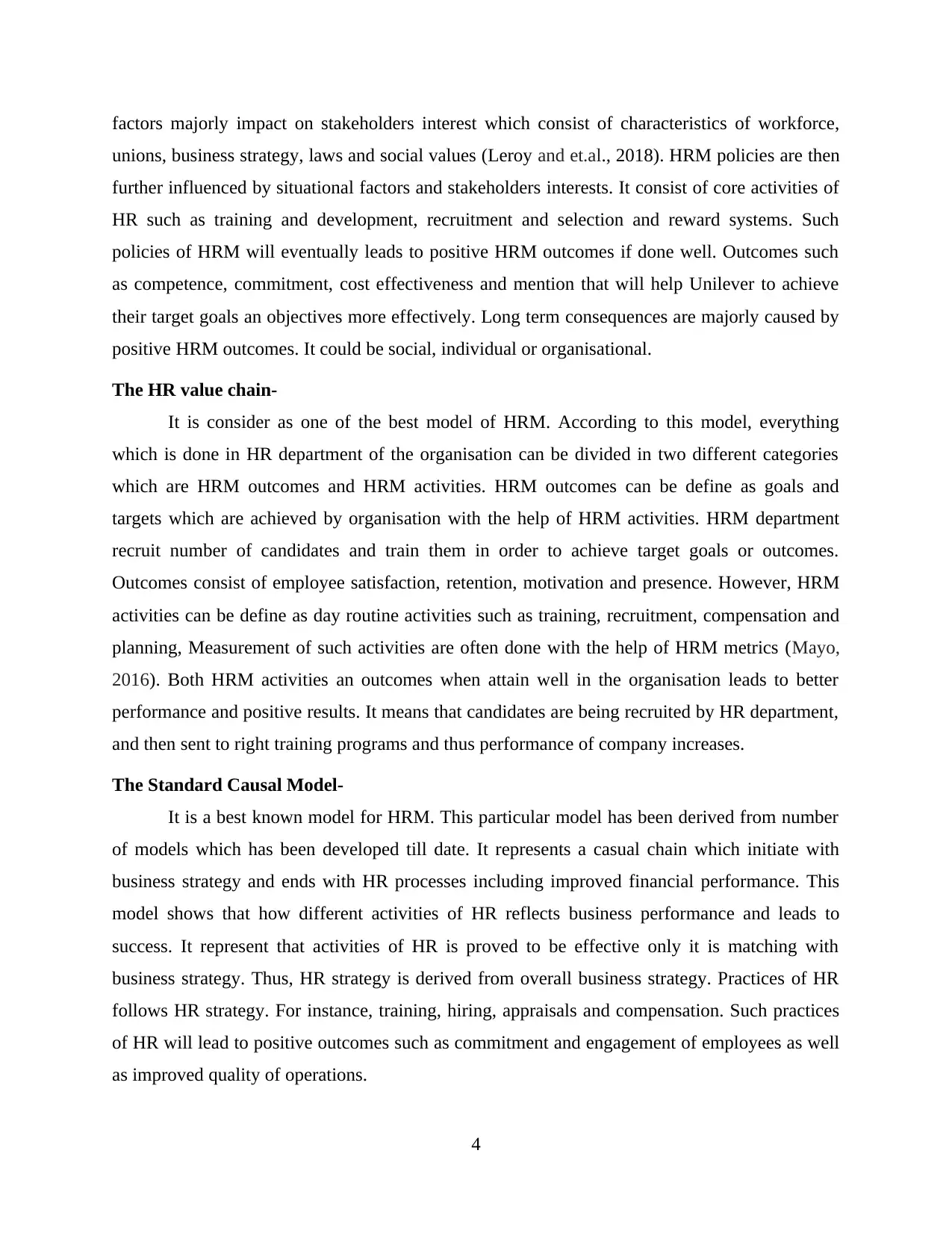
factors majorly impact on stakeholders interest which consist of characteristics of workforce,
unions, business strategy, laws and social values (Leroy and et.al., 2018). HRM policies are then
further influenced by situational factors and stakeholders interests. It consist of core activities of
HR such as training and development, recruitment and selection and reward systems. Such
policies of HRM will eventually leads to positive HRM outcomes if done well. Outcomes such
as competence, commitment, cost effectiveness and mention that will help Unilever to achieve
their target goals an objectives more effectively. Long term consequences are majorly caused by
positive HRM outcomes. It could be social, individual or organisational.
The HR value chain-
It is consider as one of the best model of HRM. According to this model, everything
which is done in HR department of the organisation can be divided in two different categories
which are HRM outcomes and HRM activities. HRM outcomes can be define as goals and
targets which are achieved by organisation with the help of HRM activities. HRM department
recruit number of candidates and train them in order to achieve target goals or outcomes.
Outcomes consist of employee satisfaction, retention, motivation and presence. However, HRM
activities can be define as day routine activities such as training, recruitment, compensation and
planning, Measurement of such activities are often done with the help of HRM metrics (Mayo,
2016). Both HRM activities an outcomes when attain well in the organisation leads to better
performance and positive results. It means that candidates are being recruited by HR department,
and then sent to right training programs and thus performance of company increases.
The Standard Causal Model-
It is a best known model for HRM. This particular model has been derived from number
of models which has been developed till date. It represents a casual chain which initiate with
business strategy and ends with HR processes including improved financial performance. This
model shows that how different activities of HR reflects business performance and leads to
success. It represent that activities of HR is proved to be effective only it is matching with
business strategy. Thus, HR strategy is derived from overall business strategy. Practices of HR
follows HR strategy. For instance, training, hiring, appraisals and compensation. Such practices
of HR will lead to positive outcomes such as commitment and engagement of employees as well
as improved quality of operations.
4
unions, business strategy, laws and social values (Leroy and et.al., 2018). HRM policies are then
further influenced by situational factors and stakeholders interests. It consist of core activities of
HR such as training and development, recruitment and selection and reward systems. Such
policies of HRM will eventually leads to positive HRM outcomes if done well. Outcomes such
as competence, commitment, cost effectiveness and mention that will help Unilever to achieve
their target goals an objectives more effectively. Long term consequences are majorly caused by
positive HRM outcomes. It could be social, individual or organisational.
The HR value chain-
It is consider as one of the best model of HRM. According to this model, everything
which is done in HR department of the organisation can be divided in two different categories
which are HRM outcomes and HRM activities. HRM outcomes can be define as goals and
targets which are achieved by organisation with the help of HRM activities. HRM department
recruit number of candidates and train them in order to achieve target goals or outcomes.
Outcomes consist of employee satisfaction, retention, motivation and presence. However, HRM
activities can be define as day routine activities such as training, recruitment, compensation and
planning, Measurement of such activities are often done with the help of HRM metrics (Mayo,
2016). Both HRM activities an outcomes when attain well in the organisation leads to better
performance and positive results. It means that candidates are being recruited by HR department,
and then sent to right training programs and thus performance of company increases.
The Standard Causal Model-
It is a best known model for HRM. This particular model has been derived from number
of models which has been developed till date. It represents a casual chain which initiate with
business strategy and ends with HR processes including improved financial performance. This
model shows that how different activities of HR reflects business performance and leads to
success. It represent that activities of HR is proved to be effective only it is matching with
business strategy. Thus, HR strategy is derived from overall business strategy. Practices of HR
follows HR strategy. For instance, training, hiring, appraisals and compensation. Such practices
of HR will lead to positive outcomes such as commitment and engagement of employees as well
as improved quality of operations.
4
Paraphrase This Document
Need a fresh take? Get an instant paraphrase of this document with our AI Paraphraser
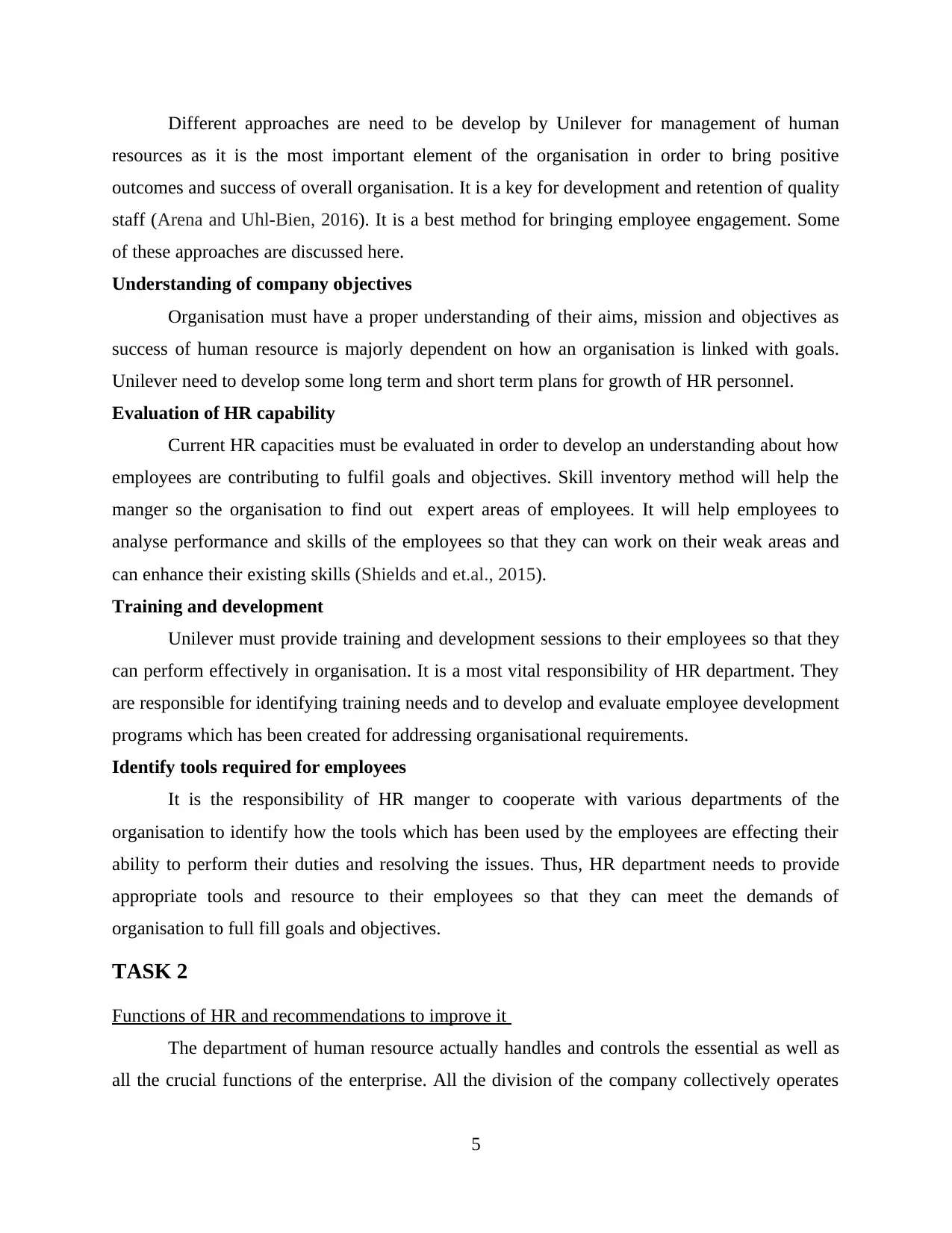
Different approaches are need to be develop by Unilever for management of human
resources as it is the most important element of the organisation in order to bring positive
outcomes and success of overall organisation. It is a key for development and retention of quality
staff (Arena and Uhl-Bien, 2016). It is a best method for bringing employee engagement. Some
of these approaches are discussed here.
Understanding of company objectives
Organisation must have a proper understanding of their aims, mission and objectives as
success of human resource is majorly dependent on how an organisation is linked with goals.
Unilever need to develop some long term and short term plans for growth of HR personnel.
Evaluation of HR capability
Current HR capacities must be evaluated in order to develop an understanding about how
employees are contributing to fulfil goals and objectives. Skill inventory method will help the
manger so the organisation to find out expert areas of employees. It will help employees to
analyse performance and skills of the employees so that they can work on their weak areas and
can enhance their existing skills (Shields and et.al., 2015).
Training and development
Unilever must provide training and development sessions to their employees so that they
can perform effectively in organisation. It is a most vital responsibility of HR department. They
are responsible for identifying training needs and to develop and evaluate employee development
programs which has been created for addressing organisational requirements.
Identify tools required for employees
It is the responsibility of HR manger to cooperate with various departments of the
organisation to identify how the tools which has been used by the employees are effecting their
ability to perform their duties and resolving the issues. Thus, HR department needs to provide
appropriate tools and resource to their employees so that they can meet the demands of
organisation to full fill goals and objectives.
TASK 2
Functions of HR and recommendations to improve it
The department of human resource actually handles and controls the essential as well as
all the crucial functions of the enterprise. All the division of the company collectively operates
5
resources as it is the most important element of the organisation in order to bring positive
outcomes and success of overall organisation. It is a key for development and retention of quality
staff (Arena and Uhl-Bien, 2016). It is a best method for bringing employee engagement. Some
of these approaches are discussed here.
Understanding of company objectives
Organisation must have a proper understanding of their aims, mission and objectives as
success of human resource is majorly dependent on how an organisation is linked with goals.
Unilever need to develop some long term and short term plans for growth of HR personnel.
Evaluation of HR capability
Current HR capacities must be evaluated in order to develop an understanding about how
employees are contributing to fulfil goals and objectives. Skill inventory method will help the
manger so the organisation to find out expert areas of employees. It will help employees to
analyse performance and skills of the employees so that they can work on their weak areas and
can enhance their existing skills (Shields and et.al., 2015).
Training and development
Unilever must provide training and development sessions to their employees so that they
can perform effectively in organisation. It is a most vital responsibility of HR department. They
are responsible for identifying training needs and to develop and evaluate employee development
programs which has been created for addressing organisational requirements.
Identify tools required for employees
It is the responsibility of HR manger to cooperate with various departments of the
organisation to identify how the tools which has been used by the employees are effecting their
ability to perform their duties and resolving the issues. Thus, HR department needs to provide
appropriate tools and resource to their employees so that they can meet the demands of
organisation to full fill goals and objectives.
TASK 2
Functions of HR and recommendations to improve it
The department of human resource actually handles and controls the essential as well as
all the crucial functions of the enterprise. All the division of the company collectively operates
5
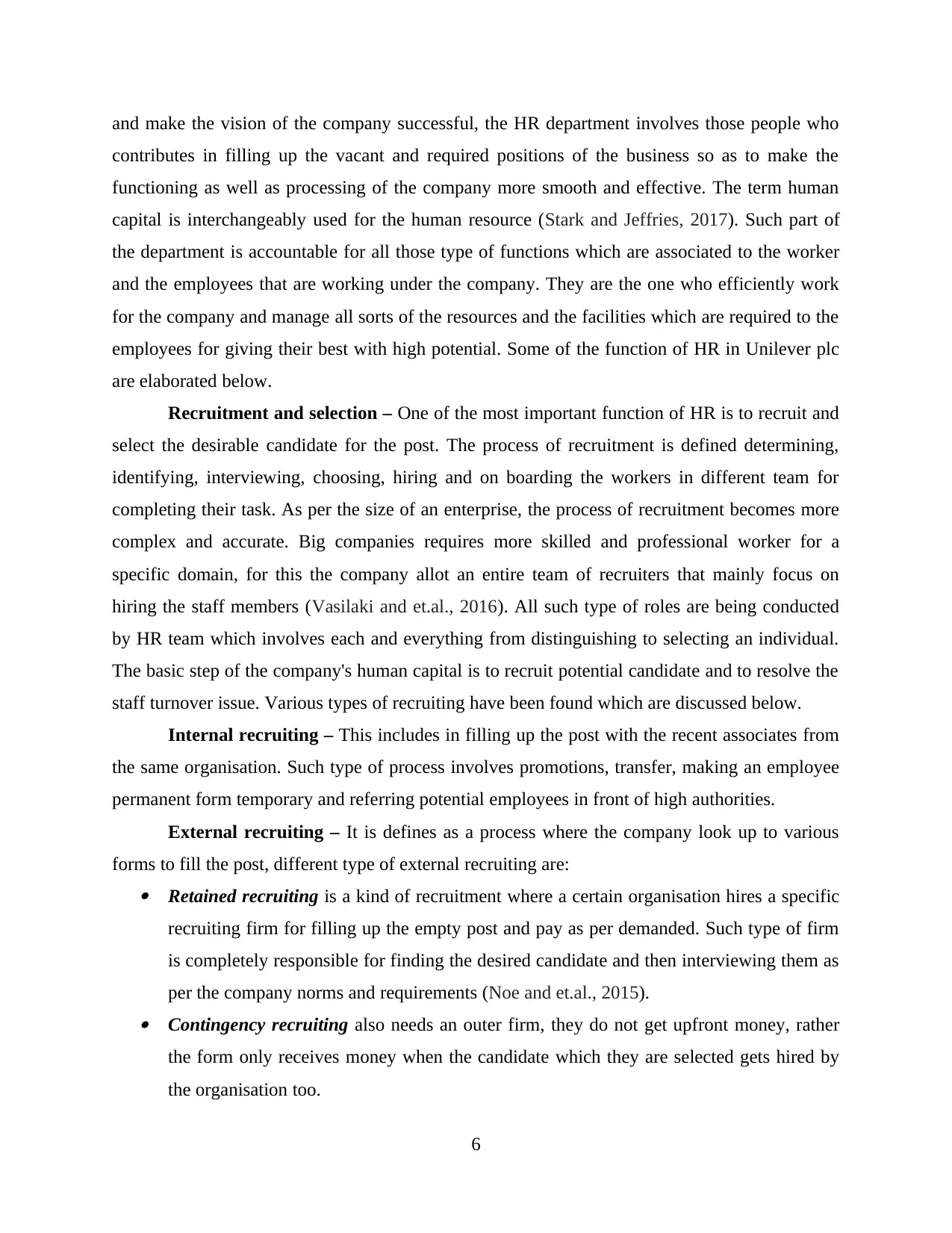
and make the vision of the company successful, the HR department involves those people who
contributes in filling up the vacant and required positions of the business so as to make the
functioning as well as processing of the company more smooth and effective. The term human
capital is interchangeably used for the human resource (Stark and Jeffries, 2017). Such part of
the department is accountable for all those type of functions which are associated to the worker
and the employees that are working under the company. They are the one who efficiently work
for the company and manage all sorts of the resources and the facilities which are required to the
employees for giving their best with high potential. Some of the function of HR in Unilever plc
are elaborated below.
Recruitment and selection – One of the most important function of HR is to recruit and
select the desirable candidate for the post. The process of recruitment is defined determining,
identifying, interviewing, choosing, hiring and on boarding the workers in different team for
completing their task. As per the size of an enterprise, the process of recruitment becomes more
complex and accurate. Big companies requires more skilled and professional worker for a
specific domain, for this the company allot an entire team of recruiters that mainly focus on
hiring the staff members (Vasilaki and et.al., 2016). All such type of roles are being conducted
by HR team which involves each and everything from distinguishing to selecting an individual.
The basic step of the company's human capital is to recruit potential candidate and to resolve the
staff turnover issue. Various types of recruiting have been found which are discussed below.
Internal recruiting – This includes in filling up the post with the recent associates from
the same organisation. Such type of process involves promotions, transfer, making an employee
permanent form temporary and referring potential employees in front of high authorities.
External recruiting – It is defines as a process where the company look up to various
forms to fill the post, different type of external recruiting are: Retained recruiting is a kind of recruitment where a certain organisation hires a specific
recruiting firm for filling up the empty post and pay as per demanded. Such type of firm
is completely responsible for finding the desired candidate and then interviewing them as
per the company norms and requirements (Noe and et.al., 2015). Contingency recruiting also needs an outer firm, they do not get upfront money, rather
the form only receives money when the candidate which they are selected gets hired by
the organisation too.
6
contributes in filling up the vacant and required positions of the business so as to make the
functioning as well as processing of the company more smooth and effective. The term human
capital is interchangeably used for the human resource (Stark and Jeffries, 2017). Such part of
the department is accountable for all those type of functions which are associated to the worker
and the employees that are working under the company. They are the one who efficiently work
for the company and manage all sorts of the resources and the facilities which are required to the
employees for giving their best with high potential. Some of the function of HR in Unilever plc
are elaborated below.
Recruitment and selection – One of the most important function of HR is to recruit and
select the desirable candidate for the post. The process of recruitment is defined determining,
identifying, interviewing, choosing, hiring and on boarding the workers in different team for
completing their task. As per the size of an enterprise, the process of recruitment becomes more
complex and accurate. Big companies requires more skilled and professional worker for a
specific domain, for this the company allot an entire team of recruiters that mainly focus on
hiring the staff members (Vasilaki and et.al., 2016). All such type of roles are being conducted
by HR team which involves each and everything from distinguishing to selecting an individual.
The basic step of the company's human capital is to recruit potential candidate and to resolve the
staff turnover issue. Various types of recruiting have been found which are discussed below.
Internal recruiting – This includes in filling up the post with the recent associates from
the same organisation. Such type of process involves promotions, transfer, making an employee
permanent form temporary and referring potential employees in front of high authorities.
External recruiting – It is defines as a process where the company look up to various
forms to fill the post, different type of external recruiting are: Retained recruiting is a kind of recruitment where a certain organisation hires a specific
recruiting firm for filling up the empty post and pay as per demanded. Such type of firm
is completely responsible for finding the desired candidate and then interviewing them as
per the company norms and requirements (Noe and et.al., 2015). Contingency recruiting also needs an outer firm, they do not get upfront money, rather
the form only receives money when the candidate which they are selected gets hired by
the organisation too.
6
⊘ This is a preview!⊘
Do you want full access?
Subscribe today to unlock all pages.

Trusted by 1+ million students worldwide
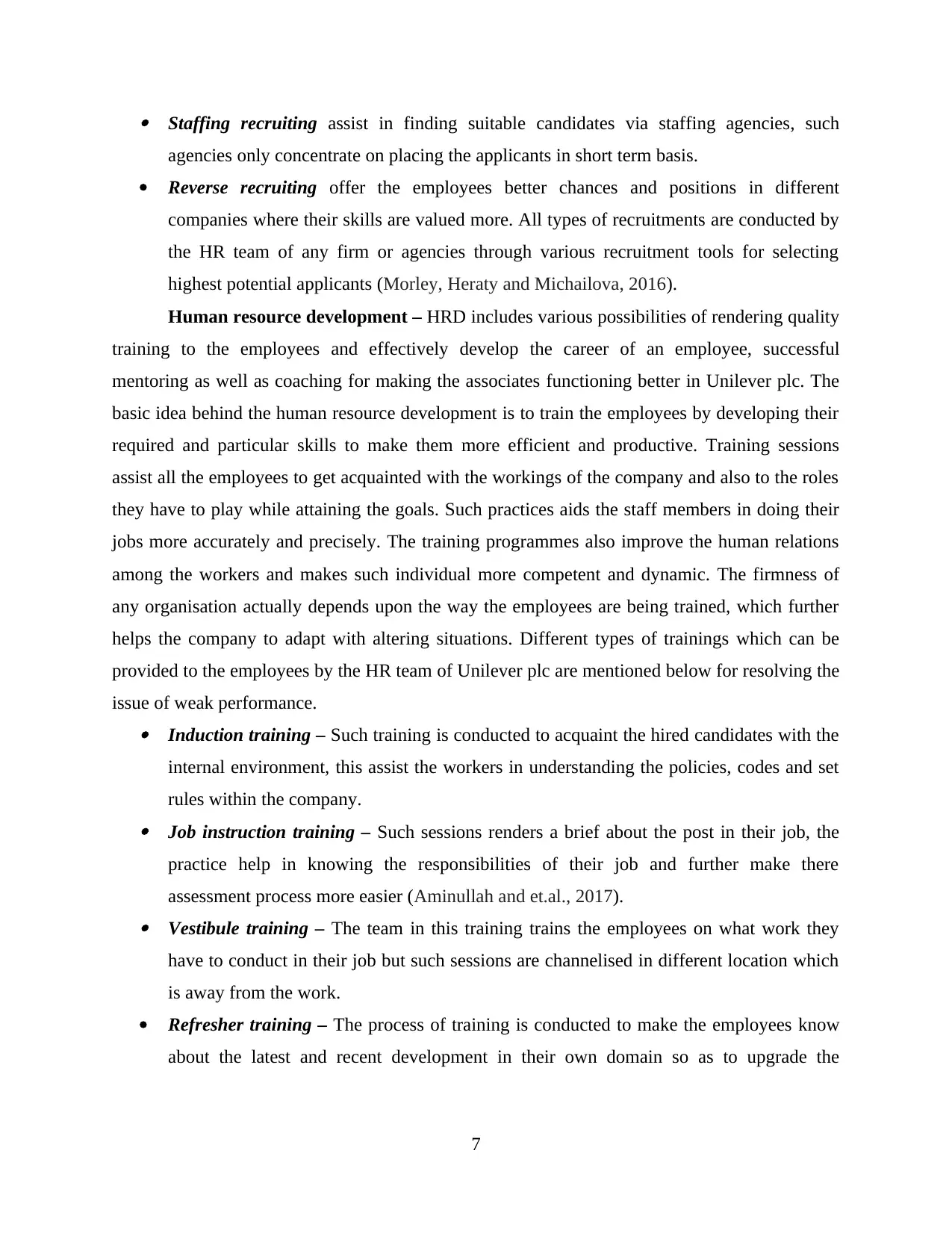
Staffing recruiting assist in finding suitable candidates via staffing agencies, such
agencies only concentrate on placing the applicants in short term basis.
Reverse recruiting offer the employees better chances and positions in different
companies where their skills are valued more. All types of recruitments are conducted by
the HR team of any firm or agencies through various recruitment tools for selecting
highest potential applicants (Morley, Heraty and Michailova, 2016).
Human resource development – HRD includes various possibilities of rendering quality
training to the employees and effectively develop the career of an employee, successful
mentoring as well as coaching for making the associates functioning better in Unilever plc. The
basic idea behind the human resource development is to train the employees by developing their
required and particular skills to make them more efficient and productive. Training sessions
assist all the employees to get acquainted with the workings of the company and also to the roles
they have to play while attaining the goals. Such practices aids the staff members in doing their
jobs more accurately and precisely. The training programmes also improve the human relations
among the workers and makes such individual more competent and dynamic. The firmness of
any organisation actually depends upon the way the employees are being trained, which further
helps the company to adapt with altering situations. Different types of trainings which can be
provided to the employees by the HR team of Unilever plc are mentioned below for resolving the
issue of weak performance. Induction training – Such training is conducted to acquaint the hired candidates with the
internal environment, this assist the workers in understanding the policies, codes and set
rules within the company. Job instruction training – Such sessions renders a brief about the post in their job, the
practice help in knowing the responsibilities of their job and further make there
assessment process more easier (Aminullah and et.al., 2017). Vestibule training – The team in this training trains the employees on what work they
have to conduct in their job but such sessions are channelised in different location which
is away from the work.
Refresher training – The process of training is conducted to make the employees know
about the latest and recent development in their own domain so as to upgrade the
7
agencies only concentrate on placing the applicants in short term basis.
Reverse recruiting offer the employees better chances and positions in different
companies where their skills are valued more. All types of recruitments are conducted by
the HR team of any firm or agencies through various recruitment tools for selecting
highest potential applicants (Morley, Heraty and Michailova, 2016).
Human resource development – HRD includes various possibilities of rendering quality
training to the employees and effectively develop the career of an employee, successful
mentoring as well as coaching for making the associates functioning better in Unilever plc. The
basic idea behind the human resource development is to train the employees by developing their
required and particular skills to make them more efficient and productive. Training sessions
assist all the employees to get acquainted with the workings of the company and also to the roles
they have to play while attaining the goals. Such practices aids the staff members in doing their
jobs more accurately and precisely. The training programmes also improve the human relations
among the workers and makes such individual more competent and dynamic. The firmness of
any organisation actually depends upon the way the employees are being trained, which further
helps the company to adapt with altering situations. Different types of trainings which can be
provided to the employees by the HR team of Unilever plc are mentioned below for resolving the
issue of weak performance. Induction training – Such training is conducted to acquaint the hired candidates with the
internal environment, this assist the workers in understanding the policies, codes and set
rules within the company. Job instruction training – Such sessions renders a brief about the post in their job, the
practice help in knowing the responsibilities of their job and further make there
assessment process more easier (Aminullah and et.al., 2017). Vestibule training – The team in this training trains the employees on what work they
have to conduct in their job but such sessions are channelised in different location which
is away from the work.
Refresher training – The process of training is conducted to make the employees know
about the latest and recent development in their own domain so as to upgrade the
7
Paraphrase This Document
Need a fresh take? Get an instant paraphrase of this document with our AI Paraphraser
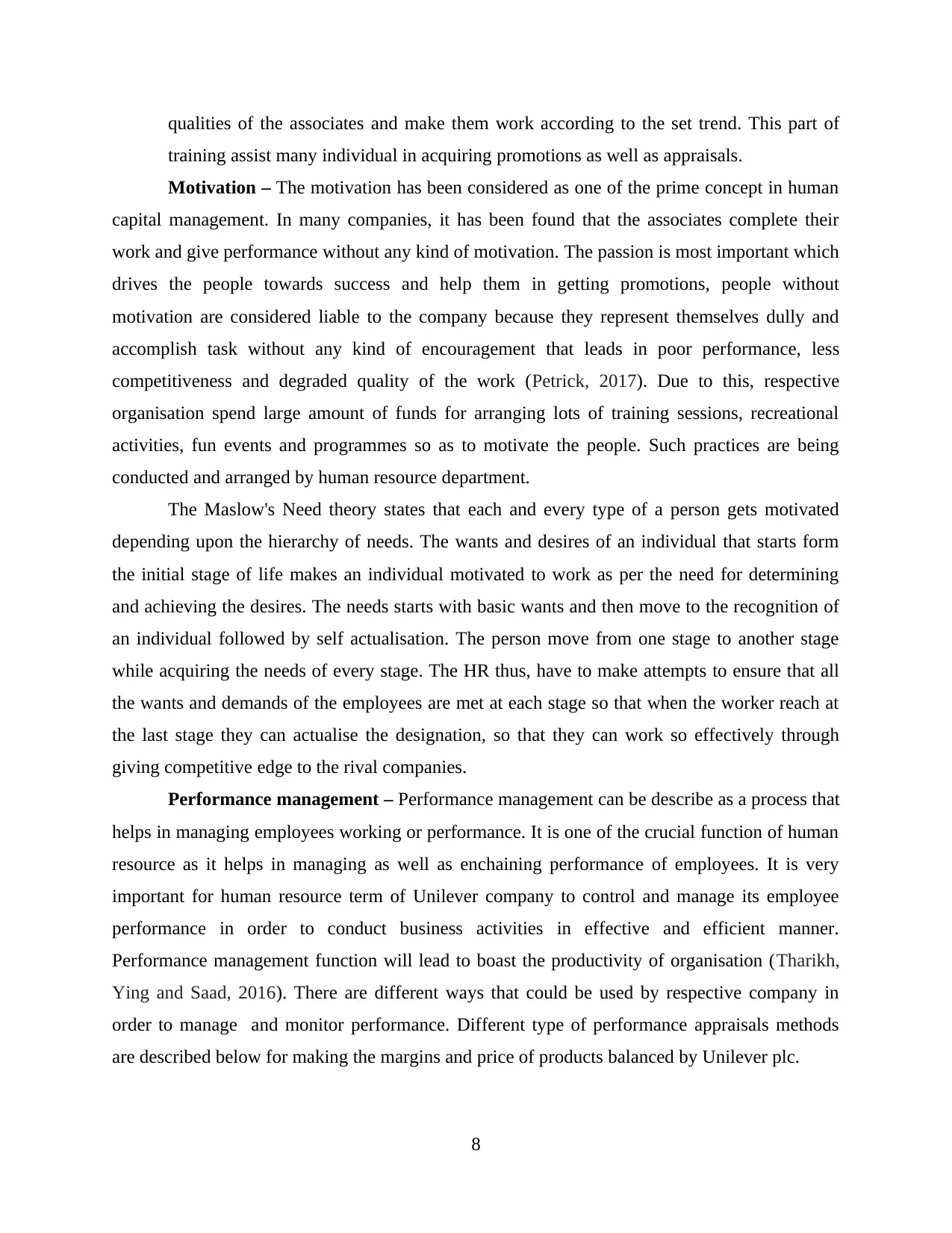
qualities of the associates and make them work according to the set trend. This part of
training assist many individual in acquiring promotions as well as appraisals.
Motivation – The motivation has been considered as one of the prime concept in human
capital management. In many companies, it has been found that the associates complete their
work and give performance without any kind of motivation. The passion is most important which
drives the people towards success and help them in getting promotions, people without
motivation are considered liable to the company because they represent themselves dully and
accomplish task without any kind of encouragement that leads in poor performance, less
competitiveness and degraded quality of the work (Petrick, 2017). Due to this, respective
organisation spend large amount of funds for arranging lots of training sessions, recreational
activities, fun events and programmes so as to motivate the people. Such practices are being
conducted and arranged by human resource department.
The Maslow's Need theory states that each and every type of a person gets motivated
depending upon the hierarchy of needs. The wants and desires of an individual that starts form
the initial stage of life makes an individual motivated to work as per the need for determining
and achieving the desires. The needs starts with basic wants and then move to the recognition of
an individual followed by self actualisation. The person move from one stage to another stage
while acquiring the needs of every stage. The HR thus, have to make attempts to ensure that all
the wants and demands of the employees are met at each stage so that when the worker reach at
the last stage they can actualise the designation, so that they can work so effectively through
giving competitive edge to the rival companies.
Performance management – Performance management can be describe as a process that
helps in managing employees working or performance. It is one of the crucial function of human
resource as it helps in managing as well as enchaining performance of employees. It is very
important for human resource term of Unilever company to control and manage its employee
performance in order to conduct business activities in effective and efficient manner.
Performance management function will lead to boast the productivity of organisation (Tharikh,
Ying and Saad, 2016). There are different ways that could be used by respective company in
order to manage and monitor performance. Different type of performance appraisals methods
are described below for making the margins and price of products balanced by Unilever plc.
8
training assist many individual in acquiring promotions as well as appraisals.
Motivation – The motivation has been considered as one of the prime concept in human
capital management. In many companies, it has been found that the associates complete their
work and give performance without any kind of motivation. The passion is most important which
drives the people towards success and help them in getting promotions, people without
motivation are considered liable to the company because they represent themselves dully and
accomplish task without any kind of encouragement that leads in poor performance, less
competitiveness and degraded quality of the work (Petrick, 2017). Due to this, respective
organisation spend large amount of funds for arranging lots of training sessions, recreational
activities, fun events and programmes so as to motivate the people. Such practices are being
conducted and arranged by human resource department.
The Maslow's Need theory states that each and every type of a person gets motivated
depending upon the hierarchy of needs. The wants and desires of an individual that starts form
the initial stage of life makes an individual motivated to work as per the need for determining
and achieving the desires. The needs starts with basic wants and then move to the recognition of
an individual followed by self actualisation. The person move from one stage to another stage
while acquiring the needs of every stage. The HR thus, have to make attempts to ensure that all
the wants and demands of the employees are met at each stage so that when the worker reach at
the last stage they can actualise the designation, so that they can work so effectively through
giving competitive edge to the rival companies.
Performance management – Performance management can be describe as a process that
helps in managing employees working or performance. It is one of the crucial function of human
resource as it helps in managing as well as enchaining performance of employees. It is very
important for human resource term of Unilever company to control and manage its employee
performance in order to conduct business activities in effective and efficient manner.
Performance management function will lead to boast the productivity of organisation (Tharikh,
Ying and Saad, 2016). There are different ways that could be used by respective company in
order to manage and monitor performance. Different type of performance appraisals methods
are described below for making the margins and price of products balanced by Unilever plc.
8
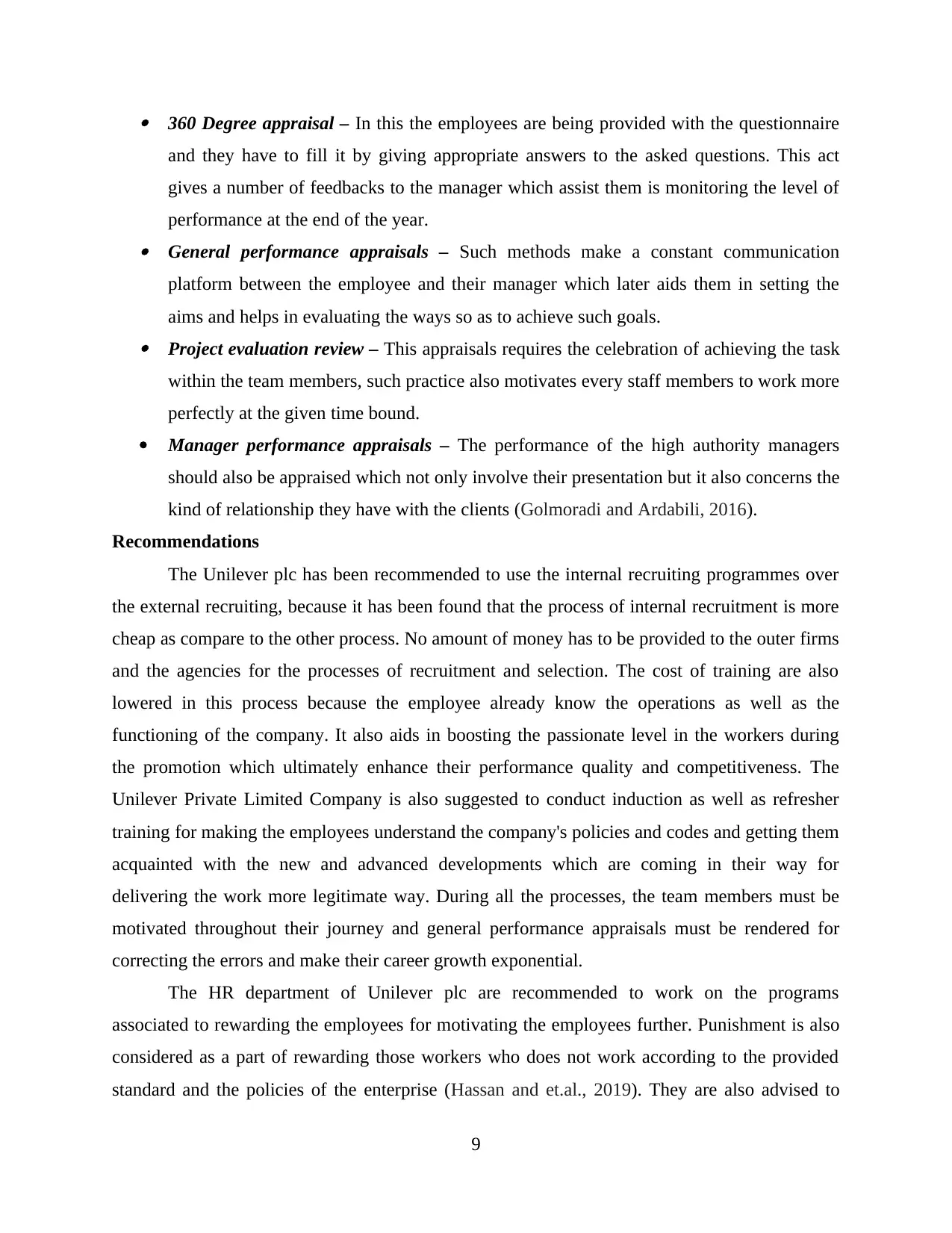
360 Degree appraisal – In this the employees are being provided with the questionnaire
and they have to fill it by giving appropriate answers to the asked questions. This act
gives a number of feedbacks to the manager which assist them is monitoring the level of
performance at the end of the year. General performance appraisals – Such methods make a constant communication
platform between the employee and their manager which later aids them in setting the
aims and helps in evaluating the ways so as to achieve such goals. Project evaluation review – This appraisals requires the celebration of achieving the task
within the team members, such practice also motivates every staff members to work more
perfectly at the given time bound.
Manager performance appraisals – The performance of the high authority managers
should also be appraised which not only involve their presentation but it also concerns the
kind of relationship they have with the clients (Golmoradi and Ardabili, 2016).
Recommendations
The Unilever plc has been recommended to use the internal recruiting programmes over
the external recruiting, because it has been found that the process of internal recruitment is more
cheap as compare to the other process. No amount of money has to be provided to the outer firms
and the agencies for the processes of recruitment and selection. The cost of training are also
lowered in this process because the employee already know the operations as well as the
functioning of the company. It also aids in boosting the passionate level in the workers during
the promotion which ultimately enhance their performance quality and competitiveness. The
Unilever Private Limited Company is also suggested to conduct induction as well as refresher
training for making the employees understand the company's policies and codes and getting them
acquainted with the new and advanced developments which are coming in their way for
delivering the work more legitimate way. During all the processes, the team members must be
motivated throughout their journey and general performance appraisals must be rendered for
correcting the errors and make their career growth exponential.
The HR department of Unilever plc are recommended to work on the programs
associated to rewarding the employees for motivating the employees further. Punishment is also
considered as a part of rewarding those workers who does not work according to the provided
standard and the policies of the enterprise (Hassan and et.al., 2019). They are also advised to
9
and they have to fill it by giving appropriate answers to the asked questions. This act
gives a number of feedbacks to the manager which assist them is monitoring the level of
performance at the end of the year. General performance appraisals – Such methods make a constant communication
platform between the employee and their manager which later aids them in setting the
aims and helps in evaluating the ways so as to achieve such goals. Project evaluation review – This appraisals requires the celebration of achieving the task
within the team members, such practice also motivates every staff members to work more
perfectly at the given time bound.
Manager performance appraisals – The performance of the high authority managers
should also be appraised which not only involve their presentation but it also concerns the
kind of relationship they have with the clients (Golmoradi and Ardabili, 2016).
Recommendations
The Unilever plc has been recommended to use the internal recruiting programmes over
the external recruiting, because it has been found that the process of internal recruitment is more
cheap as compare to the other process. No amount of money has to be provided to the outer firms
and the agencies for the processes of recruitment and selection. The cost of training are also
lowered in this process because the employee already know the operations as well as the
functioning of the company. It also aids in boosting the passionate level in the workers during
the promotion which ultimately enhance their performance quality and competitiveness. The
Unilever Private Limited Company is also suggested to conduct induction as well as refresher
training for making the employees understand the company's policies and codes and getting them
acquainted with the new and advanced developments which are coming in their way for
delivering the work more legitimate way. During all the processes, the team members must be
motivated throughout their journey and general performance appraisals must be rendered for
correcting the errors and make their career growth exponential.
The HR department of Unilever plc are recommended to work on the programs
associated to rewarding the employees for motivating the employees further. Punishment is also
considered as a part of rewarding those workers who does not work according to the provided
standard and the policies of the enterprise (Hassan and et.al., 2019). They are also advised to
9
⊘ This is a preview!⊘
Do you want full access?
Subscribe today to unlock all pages.

Trusted by 1+ million students worldwide
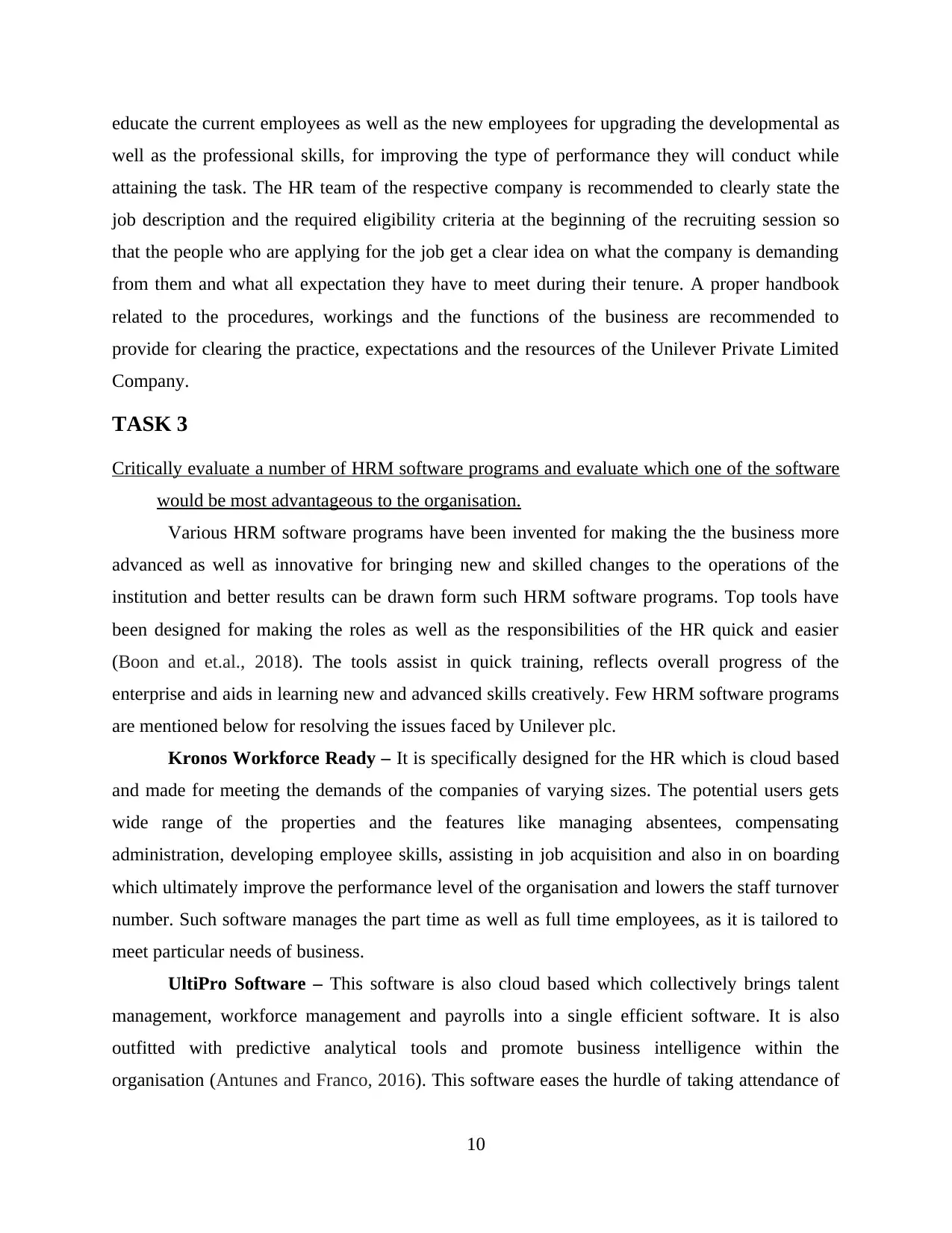
educate the current employees as well as the new employees for upgrading the developmental as
well as the professional skills, for improving the type of performance they will conduct while
attaining the task. The HR team of the respective company is recommended to clearly state the
job description and the required eligibility criteria at the beginning of the recruiting session so
that the people who are applying for the job get a clear idea on what the company is demanding
from them and what all expectation they have to meet during their tenure. A proper handbook
related to the procedures, workings and the functions of the business are recommended to
provide for clearing the practice, expectations and the resources of the Unilever Private Limited
Company.
TASK 3
Critically evaluate a number of HRM software programs and evaluate which one of the software
would be most advantageous to the organisation.
Various HRM software programs have been invented for making the the business more
advanced as well as innovative for bringing new and skilled changes to the operations of the
institution and better results can be drawn form such HRM software programs. Top tools have
been designed for making the roles as well as the responsibilities of the HR quick and easier
(Boon and et.al., 2018). The tools assist in quick training, reflects overall progress of the
enterprise and aids in learning new and advanced skills creatively. Few HRM software programs
are mentioned below for resolving the issues faced by Unilever plc.
Kronos Workforce Ready – It is specifically designed for the HR which is cloud based
and made for meeting the demands of the companies of varying sizes. The potential users gets
wide range of the properties and the features like managing absentees, compensating
administration, developing employee skills, assisting in job acquisition and also in on boarding
which ultimately improve the performance level of the organisation and lowers the staff turnover
number. Such software manages the part time as well as full time employees, as it is tailored to
meet particular needs of business.
UltiPro Software – This software is also cloud based which collectively brings talent
management, workforce management and payrolls into a single efficient software. It is also
outfitted with predictive analytical tools and promote business intelligence within the
organisation (Antunes and Franco, 2016). This software eases the hurdle of taking attendance of
10
well as the professional skills, for improving the type of performance they will conduct while
attaining the task. The HR team of the respective company is recommended to clearly state the
job description and the required eligibility criteria at the beginning of the recruiting session so
that the people who are applying for the job get a clear idea on what the company is demanding
from them and what all expectation they have to meet during their tenure. A proper handbook
related to the procedures, workings and the functions of the business are recommended to
provide for clearing the practice, expectations and the resources of the Unilever Private Limited
Company.
TASK 3
Critically evaluate a number of HRM software programs and evaluate which one of the software
would be most advantageous to the organisation.
Various HRM software programs have been invented for making the the business more
advanced as well as innovative for bringing new and skilled changes to the operations of the
institution and better results can be drawn form such HRM software programs. Top tools have
been designed for making the roles as well as the responsibilities of the HR quick and easier
(Boon and et.al., 2018). The tools assist in quick training, reflects overall progress of the
enterprise and aids in learning new and advanced skills creatively. Few HRM software programs
are mentioned below for resolving the issues faced by Unilever plc.
Kronos Workforce Ready – It is specifically designed for the HR which is cloud based
and made for meeting the demands of the companies of varying sizes. The potential users gets
wide range of the properties and the features like managing absentees, compensating
administration, developing employee skills, assisting in job acquisition and also in on boarding
which ultimately improve the performance level of the organisation and lowers the staff turnover
number. Such software manages the part time as well as full time employees, as it is tailored to
meet particular needs of business.
UltiPro Software – This software is also cloud based which collectively brings talent
management, workforce management and payrolls into a single efficient software. It is also
outfitted with predictive analytical tools and promote business intelligence within the
organisation (Antunes and Franco, 2016). This software eases the hurdle of taking attendance of
10
Paraphrase This Document
Need a fresh take? Get an instant paraphrase of this document with our AI Paraphraser
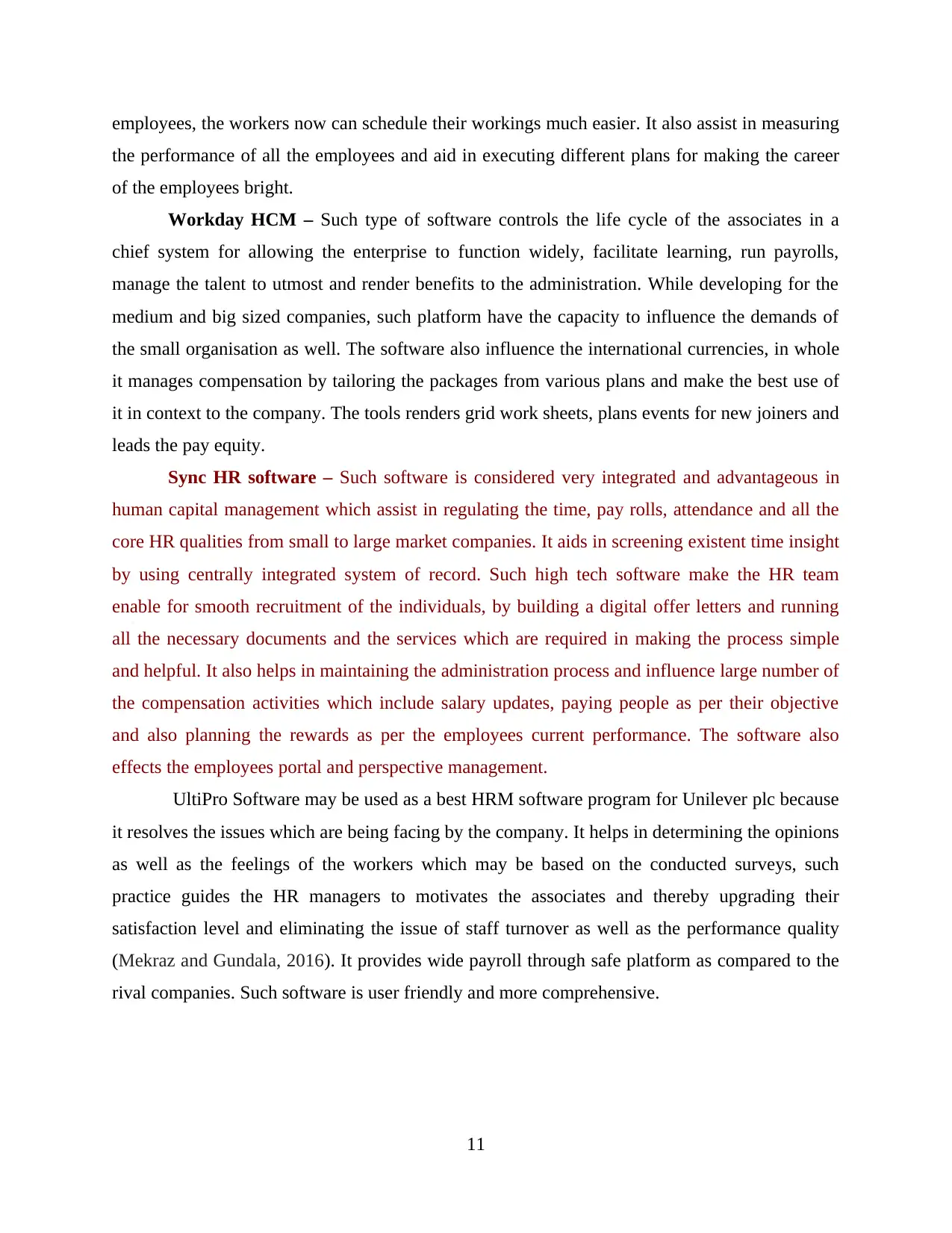
employees, the workers now can schedule their workings much easier. It also assist in measuring
the performance of all the employees and aid in executing different plans for making the career
of the employees bright.
Workday HCM – Such type of software controls the life cycle of the associates in a
chief system for allowing the enterprise to function widely, facilitate learning, run payrolls,
manage the talent to utmost and render benefits to the administration. While developing for the
medium and big sized companies, such platform have the capacity to influence the demands of
the small organisation as well. The software also influence the international currencies, in whole
it manages compensation by tailoring the packages from various plans and make the best use of
it in context to the company. The tools renders grid work sheets, plans events for new joiners and
leads the pay equity.
Sync HR software – Such software is considered very integrated and advantageous in
human capital management which assist in regulating the time, pay rolls, attendance and all the
core HR qualities from small to large market companies. It aids in screening existent time insight
by using centrally integrated system of record. Such high tech software make the HR team
enable for smooth recruitment of the individuals, by building a digital offer letters and running
all the necessary documents and the services which are required in making the process simple
and helpful. It also helps in maintaining the administration process and influence large number of
the compensation activities which include salary updates, paying people as per their objective
and also planning the rewards as per the employees current performance. The software also
effects the employees portal and perspective management.
UltiPro Software may be used as a best HRM software program for Unilever plc because
it resolves the issues which are being facing by the company. It helps in determining the opinions
as well as the feelings of the workers which may be based on the conducted surveys, such
practice guides the HR managers to motivates the associates and thereby upgrading their
satisfaction level and eliminating the issue of staff turnover as well as the performance quality
(Mekraz and Gundala, 2016). It provides wide payroll through safe platform as compared to the
rival companies. Such software is user friendly and more comprehensive.
11
the performance of all the employees and aid in executing different plans for making the career
of the employees bright.
Workday HCM – Such type of software controls the life cycle of the associates in a
chief system for allowing the enterprise to function widely, facilitate learning, run payrolls,
manage the talent to utmost and render benefits to the administration. While developing for the
medium and big sized companies, such platform have the capacity to influence the demands of
the small organisation as well. The software also influence the international currencies, in whole
it manages compensation by tailoring the packages from various plans and make the best use of
it in context to the company. The tools renders grid work sheets, plans events for new joiners and
leads the pay equity.
Sync HR software – Such software is considered very integrated and advantageous in
human capital management which assist in regulating the time, pay rolls, attendance and all the
core HR qualities from small to large market companies. It aids in screening existent time insight
by using centrally integrated system of record. Such high tech software make the HR team
enable for smooth recruitment of the individuals, by building a digital offer letters and running
all the necessary documents and the services which are required in making the process simple
and helpful. It also helps in maintaining the administration process and influence large number of
the compensation activities which include salary updates, paying people as per their objective
and also planning the rewards as per the employees current performance. The software also
effects the employees portal and perspective management.
UltiPro Software may be used as a best HRM software program for Unilever plc because
it resolves the issues which are being facing by the company. It helps in determining the opinions
as well as the feelings of the workers which may be based on the conducted surveys, such
practice guides the HR managers to motivates the associates and thereby upgrading their
satisfaction level and eliminating the issue of staff turnover as well as the performance quality
(Mekraz and Gundala, 2016). It provides wide payroll through safe platform as compared to the
rival companies. Such software is user friendly and more comprehensive.
11
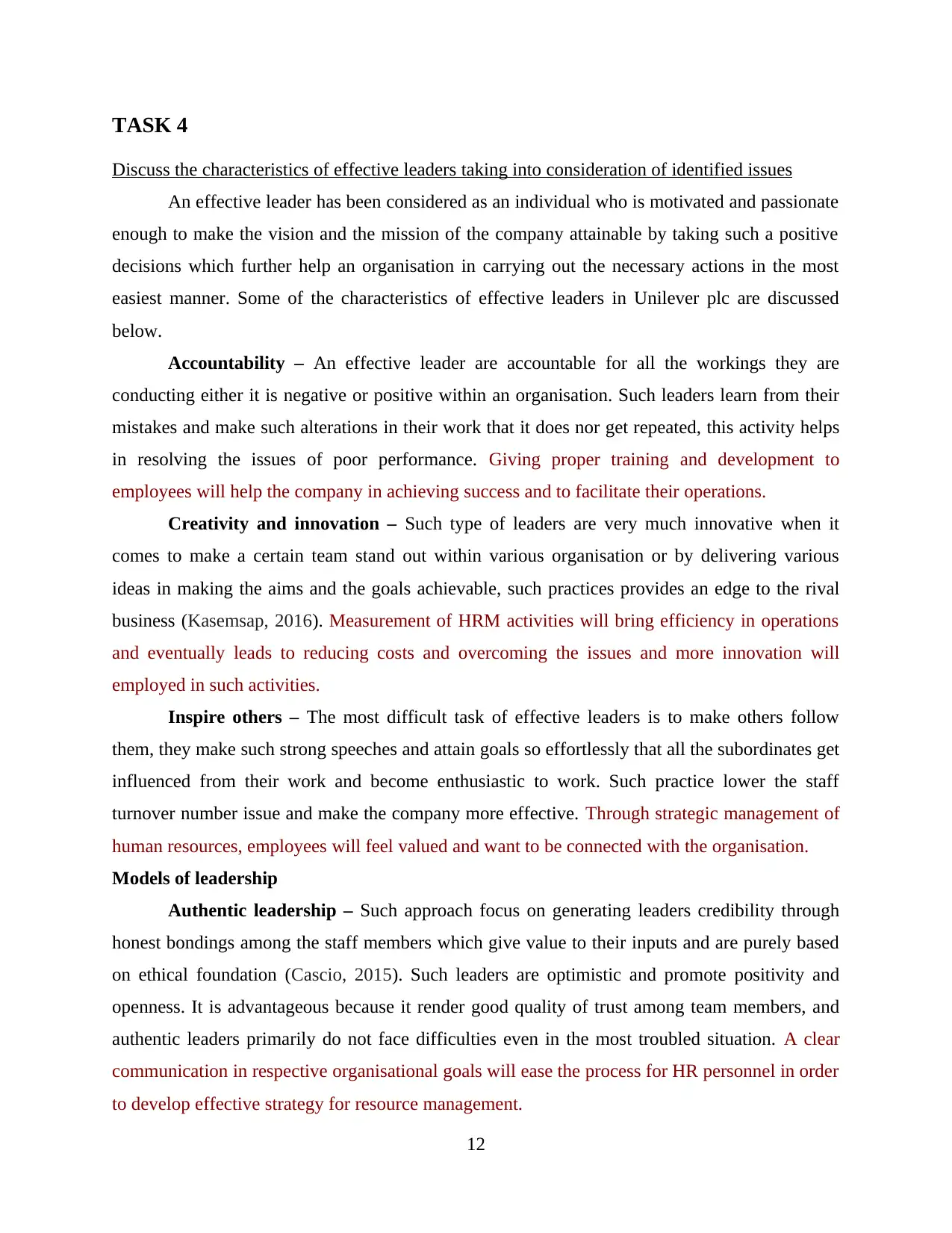
TASK 4
Discuss the characteristics of effective leaders taking into consideration of identified issues
An effective leader has been considered as an individual who is motivated and passionate
enough to make the vision and the mission of the company attainable by taking such a positive
decisions which further help an organisation in carrying out the necessary actions in the most
easiest manner. Some of the characteristics of effective leaders in Unilever plc are discussed
below.
Accountability – An effective leader are accountable for all the workings they are
conducting either it is negative or positive within an organisation. Such leaders learn from their
mistakes and make such alterations in their work that it does nor get repeated, this activity helps
in resolving the issues of poor performance. Giving proper training and development to
employees will help the company in achieving success and to facilitate their operations.
Creativity and innovation – Such type of leaders are very much innovative when it
comes to make a certain team stand out within various organisation or by delivering various
ideas in making the aims and the goals achievable, such practices provides an edge to the rival
business (Kasemsap, 2016). Measurement of HRM activities will bring efficiency in operations
and eventually leads to reducing costs and overcoming the issues and more innovation will
employed in such activities.
Inspire others – The most difficult task of effective leaders is to make others follow
them, they make such strong speeches and attain goals so effortlessly that all the subordinates get
influenced from their work and become enthusiastic to work. Such practice lower the staff
turnover number issue and make the company more effective. Through strategic management of
human resources, employees will feel valued and want to be connected with the organisation.
Models of leadership
Authentic leadership – Such approach focus on generating leaders credibility through
honest bondings among the staff members which give value to their inputs and are purely based
on ethical foundation (Cascio, 2015). Such leaders are optimistic and promote positivity and
openness. It is advantageous because it render good quality of trust among team members, and
authentic leaders primarily do not face difficulties even in the most troubled situation. A clear
communication in respective organisational goals will ease the process for HR personnel in order
to develop effective strategy for resource management.
12
Discuss the characteristics of effective leaders taking into consideration of identified issues
An effective leader has been considered as an individual who is motivated and passionate
enough to make the vision and the mission of the company attainable by taking such a positive
decisions which further help an organisation in carrying out the necessary actions in the most
easiest manner. Some of the characteristics of effective leaders in Unilever plc are discussed
below.
Accountability – An effective leader are accountable for all the workings they are
conducting either it is negative or positive within an organisation. Such leaders learn from their
mistakes and make such alterations in their work that it does nor get repeated, this activity helps
in resolving the issues of poor performance. Giving proper training and development to
employees will help the company in achieving success and to facilitate their operations.
Creativity and innovation – Such type of leaders are very much innovative when it
comes to make a certain team stand out within various organisation or by delivering various
ideas in making the aims and the goals achievable, such practices provides an edge to the rival
business (Kasemsap, 2016). Measurement of HRM activities will bring efficiency in operations
and eventually leads to reducing costs and overcoming the issues and more innovation will
employed in such activities.
Inspire others – The most difficult task of effective leaders is to make others follow
them, they make such strong speeches and attain goals so effortlessly that all the subordinates get
influenced from their work and become enthusiastic to work. Such practice lower the staff
turnover number issue and make the company more effective. Through strategic management of
human resources, employees will feel valued and want to be connected with the organisation.
Models of leadership
Authentic leadership – Such approach focus on generating leaders credibility through
honest bondings among the staff members which give value to their inputs and are purely based
on ethical foundation (Cascio, 2015). Such leaders are optimistic and promote positivity and
openness. It is advantageous because it render good quality of trust among team members, and
authentic leaders primarily do not face difficulties even in the most troubled situation. A clear
communication in respective organisational goals will ease the process for HR personnel in order
to develop effective strategy for resource management.
12
⊘ This is a preview!⊘
Do you want full access?
Subscribe today to unlock all pages.

Trusted by 1+ million students worldwide
1 out of 16
Related Documents
Your All-in-One AI-Powered Toolkit for Academic Success.
+13062052269
info@desklib.com
Available 24*7 on WhatsApp / Email
![[object Object]](/_next/static/media/star-bottom.7253800d.svg)
Unlock your academic potential
Copyright © 2020–2025 A2Z Services. All Rights Reserved. Developed and managed by ZUCOL.





